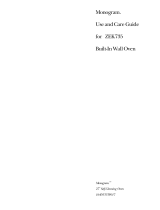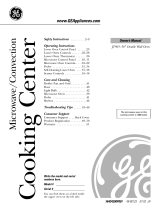4
IMPORTANT SAFETY INSTRUCTIONS
IMPORTANT SAFETY NOTICE
• The California Safe Drinking Water and
Toxic Enforcement Act requires the Governor
of California to publish a list of substances
known to the state to cause cancer, birth
defects or other reproductive harm, and
requires businesses to warn customers of
potential exposure to such substances.
• The fiberglass insulation in self-cleaning
ovens gives off a very small amount of carbon
monoxide during the cleaning cycle. Exposure
can be minimized by venting with an open
window or using a ventilation fan or hood.
SAFETY PRECAUTIONS
When using your appliance, follow basic safety
precautions, including the following:
• Use this appliance only for its intended use as
described in this guide.
• Be sure your appliance is properly installed
and grounded by a qualified technician in
accordance with the provided installation
instructions.
• Be sure the oven is securely installed in a
cabinet that is firmly attached to the house
structure. Never allow anyone to climb, sit,
stand or hang on the oven door.
• Have the installer show you the location of the
circuit breaker or fuse. Mark it for easy
reference.
• Do not attempt to repair or replace any part
of your wall oven unless it is specifically
recommended in this guide. All other
servicing should be referred to a qualified
technician.
• Teach children not to play with the controls or
any other part of the oven.
• Never leave the oven door open when you are
not watching the oven.
• Always keep dish towels, dish cloths, pot
holders and other linens a safe distance from
your oven.
• For your safety, never use your appliance for
warming or heating the room.
• Do not store flammable materials in the oven.
• Always keep wooden and plastic utensils
and canned food a safe distance away from
your oven.
• Always keep combustible wall coverings, curtains
or drapes a safe distance from your oven.
• DO NOT STORE OR USE COMBUSTIBLE
MATERIALS, GASOLINE OR OTHER
FLAMMABLE VAPORS AND LIQUIDS IN
THE VICINITY OF THIS OR ANY OTHER
APPLIANCE.
• Do not let cooking grease or other flammable
materials accumulate in or near the wall oven.
• Do not use water on grease fires. Smother fire
or flame or use a multi-purpose dry chemical
or foam-type fire extinguisher.
Flame in the oven can be smothered
completely by closing the oven door and
turning the oven off or by using a multi-
purpose dry chemical or foam-type fire
extinguisher.
• Do not use aluminum foil to line oven
bottoms, except as suggested in this guide.
Improper installation of aluminum foil may
result in a risk of electric shock or fire.
• When cooking pork, follow the directions
exactly and always cook the meat to an
internal temperature of at least 170°F. This
assures that, in the remote possibility that
trichina may be present in the meat, it will be
killed and the meat will be safe to eat.
• Before performing any service, DISCONNECT
THE OVEN POWER SUPPLY AT THE
HOUSEHOLD DISTRIBUTION PANEL BY
REMOVING THE FUSE OR SWITCHING
OFF THE CIRCUIT BREAKER.
• Do not leave children alone—children should
not be left alone or unattended in an area
where an appliance is in use. They should
never be allowed to sit or stand on any part of
the appliance.
• Keep the oven free from grease buildup.
• Keep the oven vent unobstructed.





















